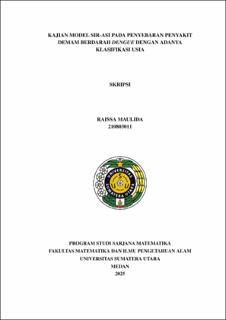Kajian Model SIR-ASI pada Penyebaran Penyakit Demam Berdarah Dengue dengan Adanya Klasifikasi Usia
Study of the SIR-ASI Model on the Spread of Dengue Fever with Age Classification

Date
2025Author
Maulida, Raissa
Advisor(s)
Syahputra, Muhammad Romi
Balqis, Muthia Ferliani
Metadata
Show full item recordAbstract
This study develops an SIR-ASI model for Dengue Hemorragic Fever (DHF) by incorporating age classification in the human population, specifically into children and adults groups. The model is structured into nine compartments: susceptible children $(S_c)$, infected children $(I_c)$, recovered children $(R_c)$, susceptible adults $(S_a)$, infected adults $(I_a)$, recovered adults $(R_a)$, aquatic mosquitoes $(A_m)$, susceptible mosquitoes $(S_m)$, and infected mosquitoes $(I_m)$. The research aims to determine two equilibrium points, the disease-free equilibrium and the endemic equilibrium, and the basic reproduction number ($R_0$), followed by a numerical simulation. The simulation results using the parameters applied over a 100-day period show that the susceptible human population, for both children and adults, decreased significantly from the first day and become constant after approximately two weeks, while the number of infected individuals increases to a peak on the fifth day, then gradually decreases to near zero. The recovered population increased in tandem with the decrease in infected cases. Interventions such as fogging were also proven effective in reducing the aquatic-stage mosquito and infected adult mosquito populations. Furthermore, the obtained basic reproduction number value of $R_0=0.025$, which is less than 1, indicates that the disease does not spread widely within the population.
Collections
- Undergraduate Theses [1486]
